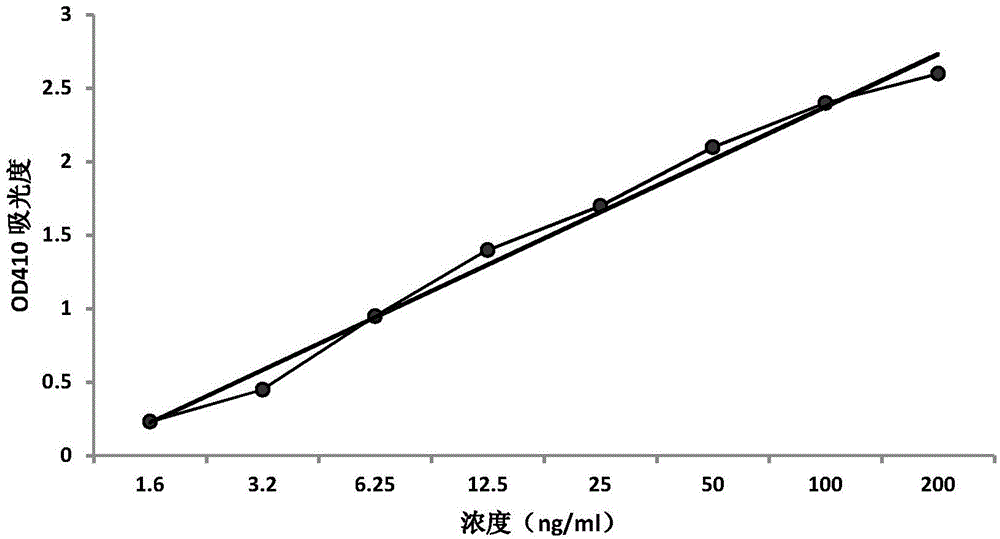Method for screening monoclonal antibodies on different binding sites of antigen
A monoclonal antibody and binding site technology, applied in the biological field, can solve a lot of workload and time problems, and achieve the effect of shortening time and simplifying the screening steps
- Summary
- Abstract
- Description
- Claims
- Application Information
AI Technical Summary
Problems solved by technology
Method used
Image
Examples
example 1
[0026] Example 1 The preparation of anti-human ST2 monoclonal antibody hybridoma cells
[0027] Mix complete Freund's adjuvant and human ST2 solution at a ratio of 1:1 to make an emulsion. Immunize female Balb / c mice aged 6-8 weeks by subcutaneous injection in multiple points (200 microliters per mouse, about 40 microliters per point). Two weeks later, incomplete Freund's adjuvant and human ST2 solution were mixed at a ratio of 1:1 to make an emulsion, and the mice were strongly immunized with human ST2 subcutaneously. Two weeks later, blood was taken to determine the titer of antibodies. Human ST2 was injected into the tail vein to boost the immunization of the mice. Four days later, the mice were sacrificed, the spleen cells were isolated, and the isolated spleen cells were fused with mouse myeloma cells SP2 / 0 cells with 50% PEG. Then selection culture was carried out in HAT-containing medium. Only confluent cells survive in HAT medium.
Embodiment 2
[0028] Example 2 Screening of anti-human ST2 monoclonal antibody hybridoma cells
[0029] Add 100 microliters of human ST2 solution dissolved in PBS buffer solution with a concentration of 1 microgram per milliliter to the small wells of the 96-well microtiter plate, and place it overnight at 4 degrees. The next day, the human ST2-coated 96-well ELISA plate was washed twice with washing solution (PBS buffer containing 0.05% Tween). Then use blocking solution (1%BSA / washing solution) to block the plate for two hours at room temperature. Pour off the blocking solution, then add 100 microliters of cell culture supernatant to the hybridoma culture solution obtained in Example 1 and add it to a 96-well plate, incubate at room temperature for 2 hours, pour off the supernatant, wash with washing solution (containing 0.05% Tween in PBS buffer) to wash the plate twice, then add 100 microliters of alkaline phosphatase-labeled goat anti-mouse IgG antibody to the wells of the 96-well EL...
Embodiment 3
[0030] Embodiment 3 Cloning culture of hybridoma cells
[0031] Monoclonal hybridoma cells can be cultured by limiting dilution. The specific method is as follows. The positive anti-human ST2 antibody hybridoma cells obtained in Example 2 were counted and serially diluted to prepare a single cell suspension with a concentration of 1 cell / 200 microliters. Add 200 microliters of single cell suspension to the wells of a 96-well cell culture plate (1 cell / 0.2ml / well). Culture in a cell incubator with 5% carbon dioxide at 37°C. About 10 days or so select the monoclonal well, detect the antibody, if positive, clone again, generally clone 3 times. Select clones with strong antibody positive and good cell growth, expand culture, establish lines, and save them.
PUM
 Login to View More
Login to View More Abstract
Description
Claims
Application Information
 Login to View More
Login to View More - R&D
- Intellectual Property
- Life Sciences
- Materials
- Tech Scout
- Unparalleled Data Quality
- Higher Quality Content
- 60% Fewer Hallucinations
Browse by: Latest US Patents, China's latest patents, Technical Efficacy Thesaurus, Application Domain, Technology Topic, Popular Technical Reports.
© 2025 PatSnap. All rights reserved.Legal|Privacy policy|Modern Slavery Act Transparency Statement|Sitemap|About US| Contact US: help@patsnap.com

